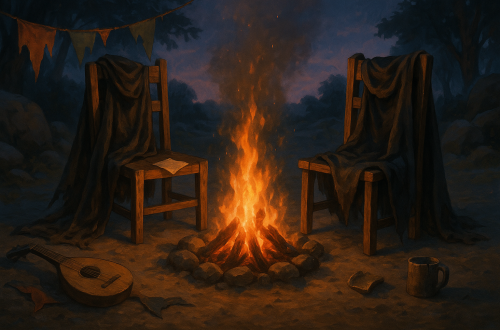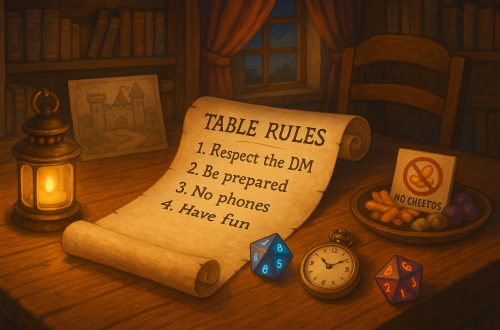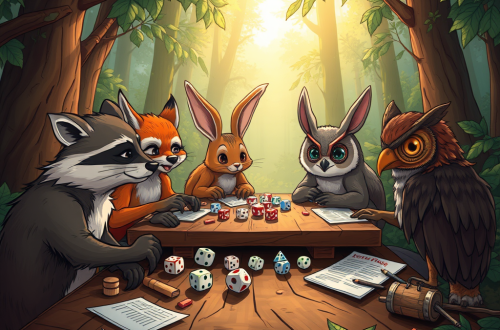Session Zero: Choosing Your Flavour
Before dice start flying everywhere and your bards start seducing literally everyone, your table has to answer the most important question:
What kind of story are we telling?
This is where tone and genre elbow their way into the room. Ignore them at your peril.
What is Tone?
Tone is your vibe, your mood, your emotional flavour. Is it hopeful? Gritty? Grim? Goofy? On a scale from epic poetry to internet memes, where do you want to land?
Examples:
- Heroic & Bright: Glory, honour, noble sacrifices, saving the world, that kind of thing.
- Grimdark: Trust no one. Everything is awful and goodness is dead.
- Comedy: Hijinks abound. Bards seduce dragons. There are undead chickens. It’s madness.
- Slice-of-Life: instead of saving the world, let’s just open a bakery.
Tone is how everything feels. It shows up in how NPCs speak, how players act, and how the GM reacts to an unexpected seduction attempt involving a basilisk and a lute.
What is Genre?
Genre is your narrative framework. Even if you decide on fantasy vs sci-fi vs whatever else, you still have to decide what kind?
Examples:
- High Fantasy: magic, monarchies, giant egos.
- Sword & Sorcery: less politics, more stabbing.
- Gothic Horror: all haunted eyes and cursed objects, probably some vampires, usually fog. You get it.
- Post-Apocalypse: the world ended and now we’re in the messy afterparty.
- Mystery & Intrigue: court secrets, poisoned chalices, political scheming.
So Why Does it Matter?
Nothing derails collaborative storytelling faster than tonal dissonance. If half your party is roleplaying Shakespeare and the other half is playing Shrek, everyone is just going to be confused. Setting tone and genre during your Session Zero ensures that players build characters that make sense in the narrative, the GM creates stories that support player expectations, and most people are either laughing or crying at the same time.
Deciding as a Group
Deciding on tone and genre as a group doesn’t have to be complicated. A good starting point is to talk about shared references: are you aiming for the epic feel of Lord of the Rings, the dark humour of The Witcher, or something more lighthearted like The Legend of Vox Machina? Using examples helps everyone get on the same page. You can also use a simple sliding scale—ask where people fall between serious and silly, or between large-scale epic and small, character-driven stories. Invite players to share genres they enjoy or are curious to explore. Often, you’ll find common ground—or discover an unexpected but exciting combination. The key is to make sure everyone has input, and that any blended tones are intentional.
An important caveat: I have, on more than one occasion, found that during Session Zero the group will say they want something like a grim, epic, serious campaign, but then the players won’t stop making dick jokes once the game starts. That’s fine, but you’ll need to figure out whether they actually want you, the GM, to match that tone, or if they are enjoying that dissonance. When the NPCs make jokes back, do the players laugh, or are they not feeling it? Sometimes the vibe will naturally change through the course of the campaign, and the GM should just go with it.
Wrapping It Up
Tone and genre aren’t just background details—they’re the scaffolding that holds the whole chaotic masterpiece together. Figuring them out early gives your campaign a clear identity and helps everyone show up to the same story, not six different ones in trench coats.
But also, be ready to adapt. Players are unpredictable creatures (bless them), and the story you all think you’re telling might shift once the dice hit the table. Maybe that gritty, serious epic turns into a heartfelt dramedy with fart jokes. That’s okay. The most important thing is that you’re aware of the shift and responding to it together, rather than tumbling into tonal chaos by accident.
Session Zero is your best chance to set that foundation—to talk, align, and laugh a little before the world explodes. Don’t skip it. Don’t rush it. Let everyone weigh in. You’re not just building a game—you’re building the rules of engagement for your shared storytelling.
Because once you know what kind of tale you’re telling… well, that’s when the magic really starts.





One Comment
Pingback: